
views
Getting Ready to Build

Consult your local building authority to learn about building codes. Learn whether you need a permits for handrail construction and whether there are standard specifications for handrails in your area. It is important to ensure that your home improvement projects are compliant with codes set in place for residential buildings. If your work requires a permit, make sure to obtain one before adding onto your home in any way. This prevents any issues that may come about with inspections, potential penalties or violations, and issues that could come about if you ever tried selling your home in the future. If you are not required to obtain a permit, move forward with your building project.
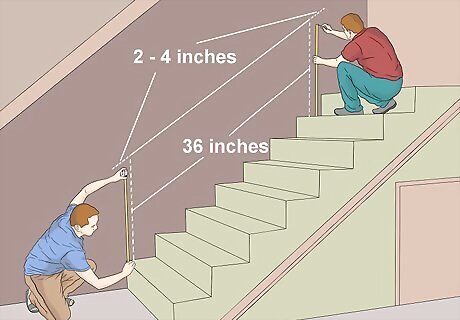
Measure the rise and the run of your stairs. The run of the railings should be measured from the top step to the bottom step of the stairs, along its diagonal. For a wall-mounted installation, add an additional 2 to 4 inches to each end to use as returns (also called the ends) for people to grab during use of the handrail.. The rise of the railing should be measured according to local building authority codes; this is usually between 34–38 inches (86–97 cm). Measure the rise at 36 inches from the same place at each step, and mark its position with a pencil or chalk. Use a tape measure to draw a straight line on the wall, connecting the 36-inch marks you placed at the top of the stairs in descending order to the very bottom step. Measure where you intend to place brackets that will later be screwed into the wall. Mark the bracket locations using a level to make sure that the brackets are plumb.

Choose a handrail style. If you’re installing an indoor handrail, it will be mounted to the wall above the stairs. Wood is the most commonly used material for indoor handrails. It is very strong and is attractive, especially oak handrails. Wood is also an option for an outdoor handrail, but is prone to rotting in all but very dry climates. Untreated wood used inside the house must be painted, or treated with oil, or stained and covered with polyurethane. If treating it with oil, use tung oil, linseed oil, or a product based in one of those oils. Avoid water-based products because although they make wood water and moisture resistant, with time they peel and degrade. Metal railings used inside the house are stylish and strong.. Synthetic railings can be shaped and molded to your style needs and can even be made to look like wood. This option is expensive compared to other handrail options, but also more durable.
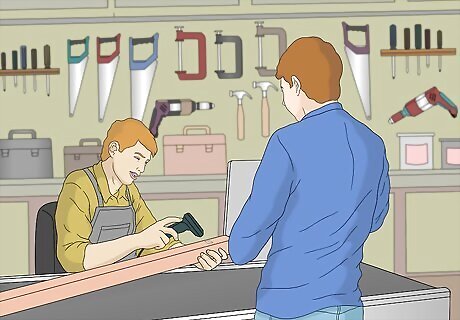
Shop for a handrail at a builders supply store, home center or hardware store. There are normally only two styles of wood available for mounting on an inside wall, wide, unfinished oak, an primed pine. The oak should be stained. The thinner pine rail material is normally used for basement stairs. Both types are normally sold only in lengths of 6 ft., 8 ft., 10 ft., etc.(or lengths of 2m, 2.5m, 3m, etc). . If you are installing a wood railing, you can bring home wood samples from your local hardware store to match them to the wood fixtures in your home.
Mounting a Handrail on a Wall Inside the House
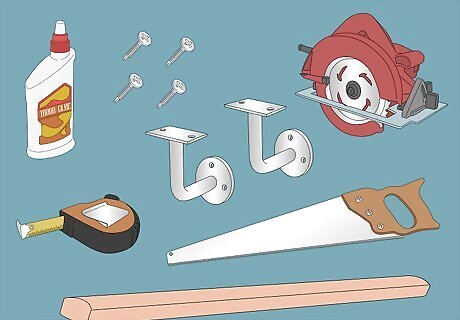
Gather your supplies. In addition to the handrail, you will need one bracket to mount at each wall stud, unless the handrail will be mounted on a brick wall (very old homes may have solid brick exterior walls). If it is a very long railing you may limit it to 4 brackets. The screws should come packaged with the brackets. You will need a drill to make pilot holes for the screws. If you own a miter saw, use this to make neat cuts. If not use a hand saw or a circular saw. . For a wall-mounted installation, the handrail should be 8 in. (20 cm) longer than your measurements if you will mount returns because you will cut off 4 inch (10 cm )on either end. Buy brackets if they were not packaged with the railing. They are normally sold in only two sizes, large and small. Each size has several colors to choose from, e.g., black, gold, and white.
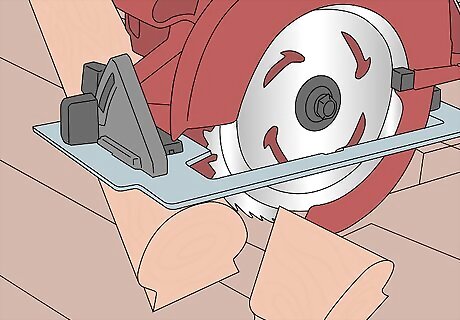
Cut the ends off of your railing. If you will not use returns cut the railing an angle, to make the cut surfaces vertical. This may be too hard if using a hand saw. The exact length will depend on where the brackets are located, the railings should extend at least 4" (10 cm) from a bracket but no more than about 10" (25 cm).. Once you've installed the handrail, the returns can be attached to either end to serve as hand grips. Reverse the placement of the cuts so that the pieces will be able to face the wall at the top and bottom of the rail.
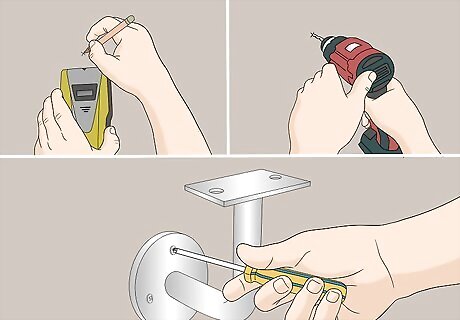
Install the brackets. Use a stud finder to find the exact edges of the wall studs you will mount to. First drill pilot holes for the screws. Mount all three screws into the wall stud, one will have to be screwed in at a slight angle. Mount brackets at the top and bottom, and set the rail on them to mark the exact locations of the remaining brackets. Repeat until all brackets are securely installed. Be sure that the brackets are vertically plumb before drilling them into place. It's important to make sure that the brackets are installed securely. If they seem loose in the wall, the handrail may not be sturdy enough to support people's weight as they use it. You may want to purchase extra brackets to ensure that the handrail will be held securely in place.
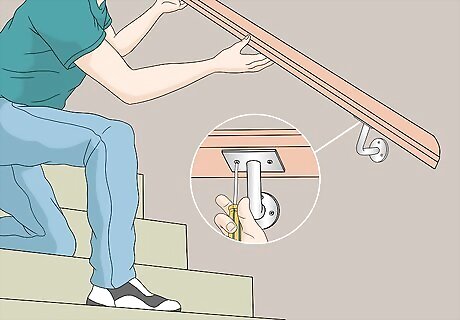
Place the railing on top of the brackets. Hold the railing in position against the wall along the length of the chalk line. Secure the handrail into its position on the brackets by placing screws into the holes drilled on the railing’s underside. Loosely-secured railings are a serious hazard issue, so be sure that the rail can bear the weight that will be imposed on it daily. If the railing is loose, reinforce the railing from below by applying a metal corner bracket there.
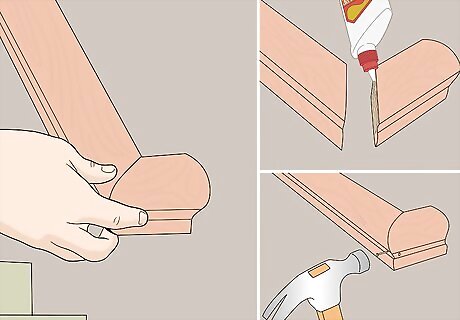
Install the returns. Place the angled edge of the return against the end of the rail. The flat end of the return should rest against the wall, forming a hand grip. Use wood glue and apply it to the cut edges before securing the return to the rail. Hold it in place for a few minutes to ensure it is securely attached. Repeat with the other return on the other end of the rail. For extra enforcement, hammer in 2-3 nails to connect the returns to the rails. You may need to shorten the returns by an inch or two to ensure that they fit securely against the wall.
Installing an Outdoor Handrail with Balusters
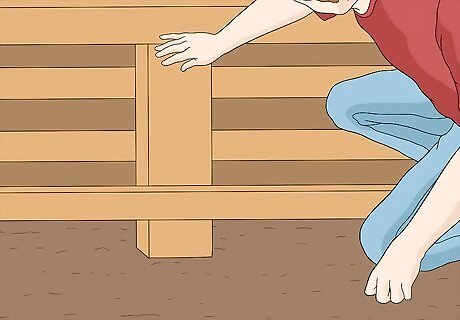
Prepare your deck or porch for building. Inspect the condition of your foundation. If repairs need to be made to floorboards, do so now. The less work done after the rail installation, the better in order to make sure the handrail stays intact for as long as possible.
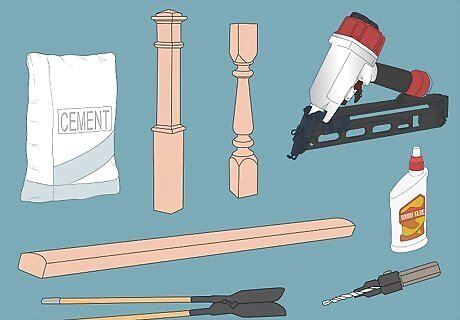
Buy your materials. To install a handrail using balusters, rather than installing one on a wall, you'll need quite a few materials in addition to the handrail you have chosen. If you're installing double handrails, one on either side of your set of stairs, double the quantity of supplies you purchase. The handrail should be a 2"x4" (5 cm x 10 cm) board of cedar or pressure treated pine. Both of these are rot resistant. Cedar can be painted with any type of paint. Pressure treated pine can only be painted with solid stain, but does not need to be painted. Buy handrail boards that are splinter-free, and very straight. Buy two 4"x4" (10 cm x 10 cm) newel posts (posts). They are normally sold in 8 ft. lengths ( 2.5 m) and longer, and must be cut. Buy one baluster for each stair step. Balusters are the spindles that connect the rail to each step. The height of the balusters should be between 30 and 36 inches, depending on how high you want the railing to be. For secure installation of newel posts, you'll need a post-hole digger and concrete mix to pour into the holes. Buy sure-tite fasteners to secure the balusters to the steps. Depending on the style of railing you install, you may need additional reinforcement supplies, such as a finish nail gun and a screwdigger.

Install the newel posts. If you're replacing an old handrail, your set of stairs may already have newel posts at the top and bottom that you can use to support your new handrail. If not, you'll need to install posts before you can install your rail. To install a post in the ground, dig a hole 18" deep and about 9" wide. You will need a post-hole digger, and if there are rocks you may need a rock bar. Stand the post in the hole and fill the hole almost to the top with concrete. To hold the post vertical while the concrete dries, nail one 1" x 2" strip from its top to the stairway, and another at a right angle, nailed to a small tent post you hammer into the ground. Use a large level to make the post perfectly vertical. Allow 3 days for the concrete to set before installing the handrail. To mount a post to a wooden deck, mount the post to the stringer. Use four Timber Lock screws or two 3/8" galvanized lag bolts with lock washers. Use construction adhesive for extra strength.

Install the balusters at the appropriate point on each stair. Make sure the balusters are lined up with the newel posts at either end of the stairs. Drill holes into each step, then thread the holes with sure-tite fasteners. If your balusters don't already have holes, you'll need to drill them. Drill a standard sized access hole into the bottom of the balusters. Into the side of each baluster, drill another access hole horizontally to intersect the first hole. Set each baluster, or spindle, onto the sure-tite fasteners on each step. Tighten them down with a wrench.
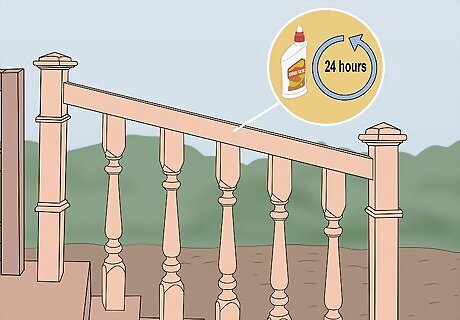
Attach the handrail to the newel posts and balusters. Apply wood glue or epoxy glue to the top of the posts. Fit the handrail into place. Wait 24 hours for the glue to dry before using the handrail, then secure the handrail and balusters together one at a time with a finish nail gun. Mount the ends of the handrail to the posts using three 3" or 3 1/2" deck screws. Screw in 2 screws from the top and one from the side. First drill pilot holes through the handrail to prevent it from cracking. Cover over the screws with exterior caulk. Caulk the gaps between the hand rails and the posts.
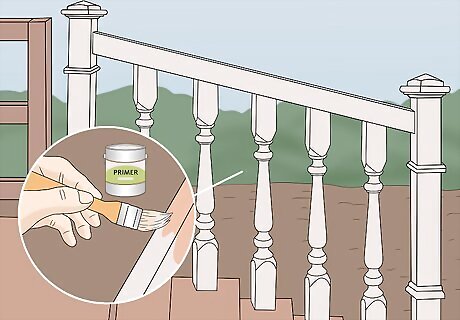
If pressure treated pine was not used, apply exterior primer to your finished handrail. After the primer dries, apply a second coat. If you paint the handrail and railing, use an oil based paint because it better withstands dirt and harsh weather. To stain the wood, choose a wood stain that contains a deck sealer to preserve the look and feel of the wood.



















Comments
0 comment